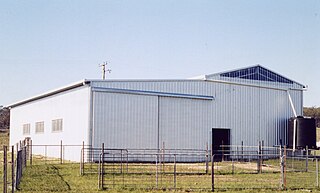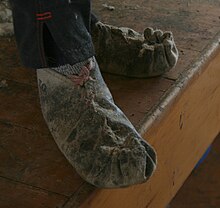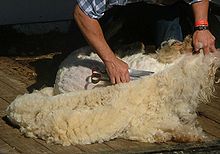
Wool is the textile fiber obtained from sheep and other mammals, especially goats, rabbits, and camelids. The term may also refer to inorganic materials, such as mineral wool and glass wool, that have some properties similar to animal wool.

Wool classing is the production of uniform, predictable, low-risk lines of wool, carried out by examining the characteristics of the wool in its raw state and classing (grading) it accordingly. Wool classing is done by a wool classer.

Cashmere wool, usually simply known as cashmere, is a fiber obtained from cashmere goats, pashmina goats, and some other breeds of goat. It has been used to make yarn, textiles and clothing for hundreds of years. Cashmere is closely associated with the Kashmir shawl, the word "cashmere" deriving from an anglicization of Kashmir, when the Kashmir shawl reached Europe in the 19th century. Both the soft undercoat and the guard hairs may be used; the softer hair is reserved for textiles, while the coarse guard hair is used for brushes and other non-apparel purposes. Cashmere is a hygroscopic fiber which essentially means that it absorbs water from the air. This helps regulate the body in both warm and cool temperatures by absorbing and releasing moisture based on the surrounding environment.

Sheep farming or sheep husbandry is the raising and breeding of domestic sheep. It is a branch of animal husbandry. Sheep are raised principally for their meat, milk, and fiber (wool). They also yield sheepskin and parchment.
A sheep shearer is a worker who uses (hand-powered)-blade or machine shears to remove wool from domestic sheep during crutching or shearing.

Crutching refers to the removal of wool from around the tail and between the rear legs of a sheep for hygiene purposes. It can also refer to removing wool from the heads of sheep. It does not refer to the process of mulesing—a controversial procedure that involves removing of strips of wool-bearing skin from around the breech (buttocks) of a sheep.

A sheep station is a large property in Australia or New Zealand, whose main activity is the raising of sheep for their wool and/or meat. In Australia, sheep stations are usually in the south-east or south-west of the country. In New Zealand the Merinos are usually in the high country of the South Island. These properties may be thousands of square kilometres in size and run low stocking rates to be able to sustainably provide enough feed and water for the stock.

Shearing sheds are large sheds located on sheep stations to accommodate large scale sheep shearing activities.

The Romney, formerly called the Romney Marsh sheep but generally referred to by the local farmers as the Kent, is a breed of sheep originating in England. The Romney is a "long-wool" breed recognized in England by 1800. Exported to other continents, the Romney is an economically important sheep breed, especially to the sheep-meat and wool export trades of New Zealand.

The raising of domestic sheep has occurred in nearly every inhabited part of the earth, and the variations in cultures and languages which have kept sheep has produced a vast lexicon of unique terminology used to describe sheep husbandry.

Alpaca fleece is the natural fiber harvested from an alpaca. There are two different types of alpaca fleece. The most common fleece type comes from a Huacaya. Huacaya fiber grows and looks similar to sheep wool in that the animal looks "fluffy". The second type of alpaca is Suri and makes up less than 10% of the South American alpaca population. Suri fiber is more similar to natural silk and hangs off the body in locks that have a dreadlock appearance. While both fibers can be used in the worsted milling process using light weight yarn or thread, Huacaya fiber can also be used in a woolen process and spun into various weight yarns. It is a soft, durable, luxurious and silky natural fiber.

The Golden Shears International Shearing and Woolhandling Championships is the world's most prestigious sheep shearing event.
Textile manufacturing is one of the oldest human activities. The oldest known textiles date back to about 5000 B.C. In order to make textiles, the first requirement is a source of fibre from which a yarn can be made, primarily by spinning. The yarn is processed by knitting or weaving to create cloth. The machine used for weaving is the loom. Cloth is finished by what are described as wet process to become fabric. The fabric may be dyed, printed or decorated by embroidering with coloured yarns.

Frederick York Wolseley was an Irish-born New South Wales inventor and woolgrower who invented and developed the first commercially successful sheep shearing machinery after extensive experimentation. It revolutionised the wool industry.

Shearing the Rams is an 1890 painting by Australian artist Tom Roberts. It depicts sheep shearers plying their trade in a timber shearing shed. Distinctly Australian in character, the painting is a celebration of pastoral life and work, especially "strong, masculine labour", and recognises the role that the wool industry played in the development of the country.

The Golden Fleece, originally known as Shearing at Newstead, is an 1894 painting by the Australian artist Tom Roberts. The painting depicts sheep shearers plying their trade in a timber shearing shed at Newstead North, a sheep station near Inverell on the Northern Tablelands of New South Wales. The same shed is depicted in another of Roberts' works, Shearing Shed, Newstead (1894).
The Wolseley Sheep Shearing Machine Company Limited was a London-incorporated public listed company created to capitalize on a sheep-shearing machinery business established by Frederick Wolseley in Australia which was managed by Herbert Austin who went on to manufacture Wolseley and Austin cars.

Chris was a Merino ram who gained international fame in September 2015 after being shorn of a record amount of wool in Canberra, Australia. Chris was named after a sheep character in the sitcom Father Ted by local Bonner resident Sue Dowling, who spotted the sheep wandering in a paddock near the Bonner district in Canberra.

Blade shearing or hand shearing is the style of shearing sheep and other animals with fibrous coats with a set of specialized scissors. It is practiced in many parts of the world as both an occupation and a sport. Commercial blade shearers shear on average 140 sheep in an 8-hour working day, but some will shear over 200 sheep in a day.
East Warrah Woolshed is a heritage-listed shearing shed at Merriwa-Murrurundi Road, Warrah Creek, Liverpool Plains Shire, New South Wales, Australia. It was designed by Samuel Craik and built from 1863 to 1864. It was added to the New South Wales State Heritage Register on 10 August 2018.























